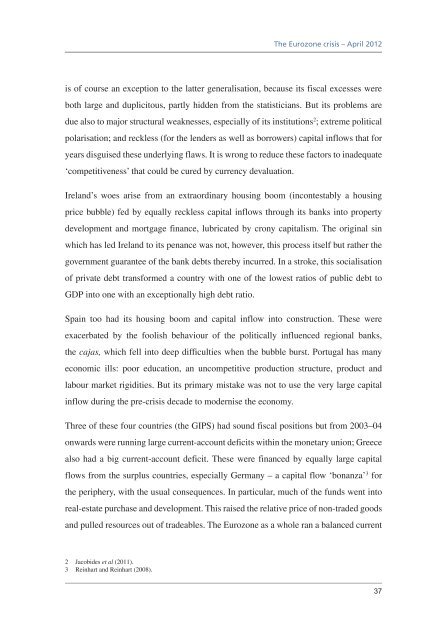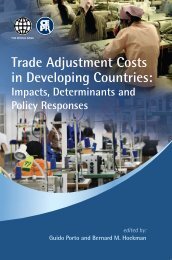Download PDF - Vox
Download PDF - Vox
Download PDF - Vox
- No tags were found...
You also want an ePaper? Increase the reach of your titles
YUMPU automatically turns print PDFs into web optimized ePapers that Google loves.
The Eurozone crisis – April 2012is of course an exception to the latter generalisation, because its fiscal excesses wereboth large and duplicitous, partly hidden from the statisticians. But its problems aredue also to major structural weaknesses, especially of its institutions 2 ; extreme politicalpolarisation; and reckless (for the lenders as well as borrowers) capital inflows that foryears disguised these underlying flaws. It is wrong to reduce these factors to inadequate‘competitiveness’ that could be cured by currency devaluation.Ireland’s woes arise from an extraordinary housing boom (incontestably a housingprice bubble) fed by equally reckless capital inflows through its banks into propertydevelopment and mortgage finance, lubricated by crony capitalism. The original sinwhich has led Ireland to its penance was not, however, this process itself but rather thegovernment guarantee of the bank debts thereby incurred. In a stroke, this socialisationof private debt transformed a country with one of the lowest ratios of public debt toGDP into one with an exceptionally high debt ratio.Spain too had its housing boom and capital inflow into construction. These wereexacerbated by the foolish behaviour of the politically influenced regional banks,the cajas, which fell into deep difficulties when the bubble burst. Portugal has manyeconomic ills: poor education, an uncompetitive production structure, product andlabour market rigidities. But its primary mistake was not to use the very large capitalinflow during the pre-crisis decade to modernise the economy.Three of these four countries (the GIPS) had sound fiscal positions but from 2003–04onwards were running large current-account deficits within the monetary union; Greecealso had a big current-account deficit. These were financed by equally large capitalflows from the surplus countries, especially Germany – a capital flow ‘bonanza’ 3 forthe periphery, with the usual consequences. In particular, much of the funds went intoreal-estate purchase and development. This raised the relative price of non-traded goodsand pulled resources out of tradeables. The Eurozone as a whole ran a balanced current2 Jacobides et al (2011).3 Reinhart and Reinhart (2008).37














